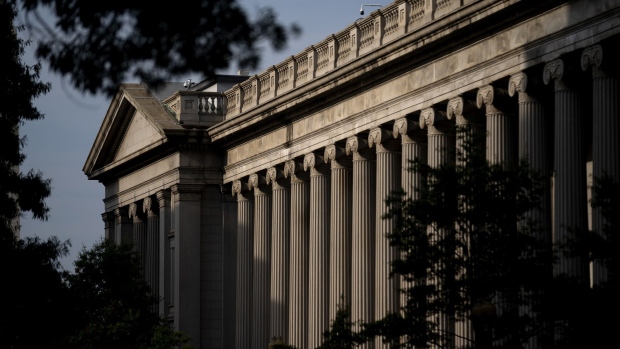Jul 31, 2021
Treasury Traders Eye Supply-Demand Risks With Yields Near Lows
, Bloomberg News

(Bloomberg) -- The timing of major upcoming shifts in Treasury supply and demand will be crucial in determining if the recent downward trend in yields continues or finally reverses.
The 10-year yield dropped 25 basis points in July, its biggest one-month fall since the pandemic panic rocked markets back in March 2020, and a fourth straight period of declines. Commentary from the Federal Reserve accompanying its most recent policy decision last week helped reinforce the idea among some observers that it’s in no huge hurry to withdraw policy support, adding to downward pressure on yields even as inflation ticks up.
The coming week will see traders turn their attention to the Treasury’s quarterly refunding announcement -- which could give clues to the supply side of the equation -- and how that’s likely to balance against any move by the Fed to dial back its asset-buying at some point down the road. Economic data such as the upcoming monthly jobs report, as always, will be key to shaping the monetary policy outlook, but the read through to markets might not be so simple.
“The extent to which Treasuries will be driven by the fundamentals is as much of an unknown as the actual data itself at this stage,” BMO strategists Ian Lyngen and Ben Jeffery wrote in a note to clients.
Treasury supply is expected to fall as the U.S. government eventually pares back the size of its debt auctions, and officials may give indications about the timing of that in the quarterly refunding announcement. If it’s sooner than the market is banking on, investors will face a more rapidly shrinking pile of securities, putting more downward pressure on rates. Conversely, a more leisurely schedule could move markets the other way. But even if the government is contemplating that, there’s no guarantee that the Treasury will give much visibility to investors beyond the upcoming quarter.
On the flipside, one of the big sources of demand in the Treasury market is also set to be in flux, with the Fed expected to inch away from its $120 billion-a-month asset-purchase program at some point. A dovish tone from Chair Jerome Powell this week helped weigh on yields, but any sign that they’re moving faster, or that trends in inflation might force their hand on policy, could be a catalyst for a renewed uptick in rates.
For Societe Generale’s Subadra Rajappa, the impact of the Fed’s pullback is likely to foster an imbalance as the pile of bonds the market has to absorb is “quite large, especially if you assume they start in November and end in mid-2022.”
Most focus is likely to be on Powell himself at the late-August Jackson Hole conference, but with that event almost a month away, the market will likely be guided for now by its own judgment of what economic data means for tapering, and what the Treasury itself says about the supply side.
The 10-year yield ended the week at 1.22%, close to its low for the week and more than half a percentage point below its highs for the year.
What to Watch
- Economic calendar:
- Aug. 2: Markit U.S. manufacturing PMI; construction spending; ISM manufacturing
- Aug. 3: Factory orders; durable goods orders
- Aug. 4: MBA mortgage applications; ADP employment change; Markit U.S. services PMI; ISM services index
- Aug. 5: Challenger job cuts; trade balance; initial jobless claims; Langer consumer comfort
- Aug. 6: Nonfarm payrolls; wholesale inventories; consumer credit
- Fed calendar:
- Aug. 3: Federal Reserve Governor Michelle Bowman
- Aug. 4: Fed Vice Chair Richard Clarida
- Aug. 5: Fed Governor Christopher Waller
- Auction schedule:
- Aug. 2: 13-, 26-week bills
- Aug. 3: 42-day cash management bills
- Aug. 4: 119-day CMBs
- Aug. 5: 4-, 8-week bills
©2021 Bloomberg L.P.


